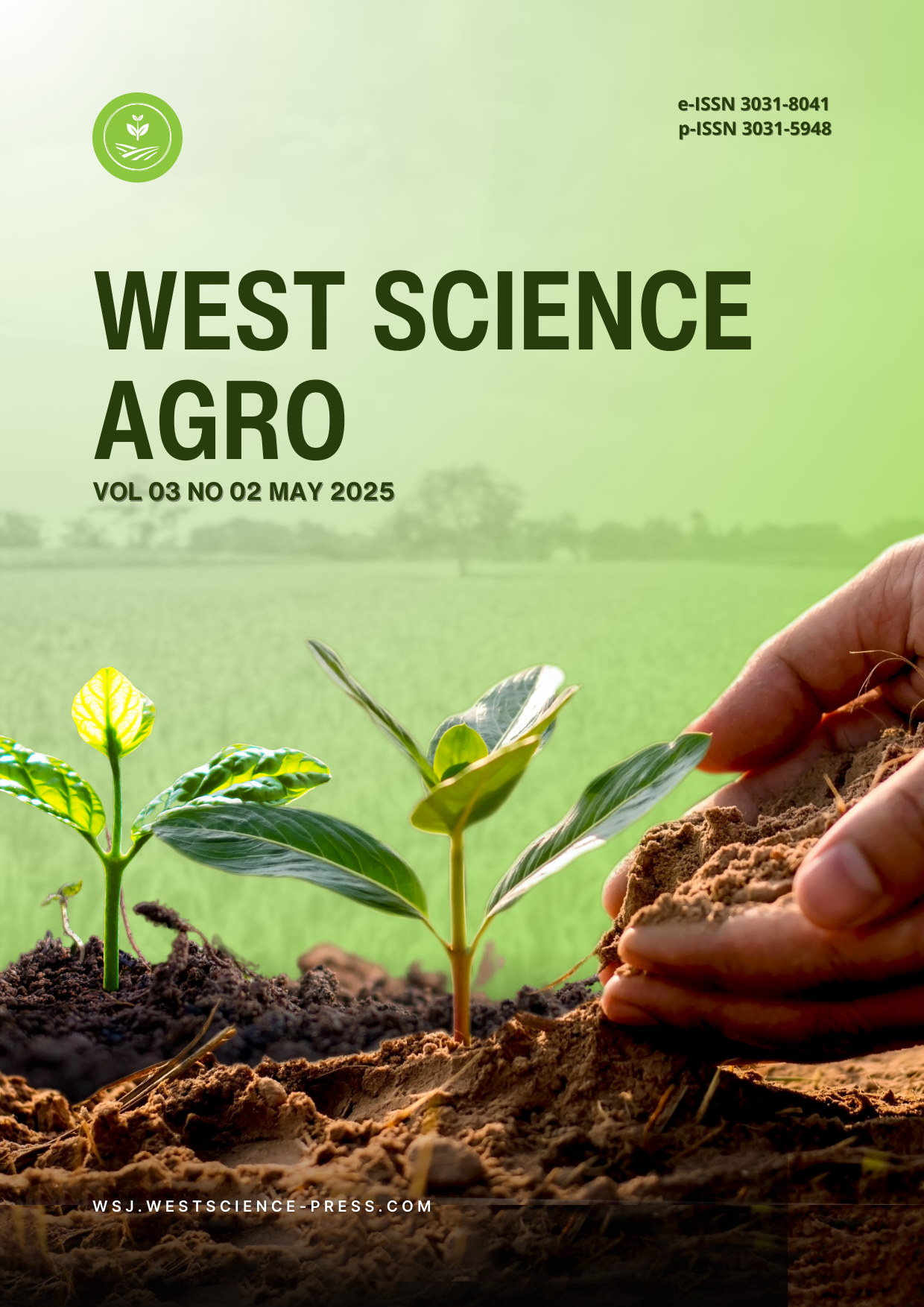The Effect of Nutrient Composition on the Growth of Kale Plants in Hydroponic Systems
DOI:
https://doi.org/10.58812/wsa.v3i02.1924Keywords:
hydroponic systems, kale growth, macronutrients, nutrient managementAbstract
This study reviews the impact of nutritional composition on the growth of kale (Brassica oleracea var. acephala) in hydroponic systems, synthesizing findings from 15 Scopus-indexed studies. The analysis highlights the critical roles of macronutrients (nitrogen, phosphorus, potassium) and micronutrients (iron, magnesium, zinc) in optimizing plant growth, yield, and quality. Additionally, it examines the importance of nutrient solution management, including pH, electrical conductivity, and nutrient concentration, for efficient nutrient uptake. Innovative practices such as organic additives and advanced monitoring systems are also discussed for their potential to enhance productivity and sustainability. The review identifies gaps in existing research, particularly in standardizing nutrient formulations and assessing the long-term impact on nutritional quality. These findings provide actionable insights for researchers and practitioners aiming to advance hydroponic kale cultivation.
References
[1] R. Taghizadeh, “Assessing the potential of hydroponic farming to reduce food imports: The case of lettuce production in Sweden.” 2021.
[2] U. Thapa, N. N. Hansda, S. Kundu, A. Giri, D. Tamang, and A. O. Rahaman, “Advancements in hydroponic systems: a comprehensive review,” Arch. Curr. Res. Int., vol. 24, no. 11, pp. 317–328, 2024.
[3] S. Dutta, B. Mukherjee, and A. Sawarkar, “Enhanced Agricultural Productivity Using Hydroponics Technique: A Smart Farming System,” in Irrigation Systems and Applications, IntechOpen, 2023.
[4] T. Alam, M. A. Ahmed, and M. Ikram, “Hydroponics as an advanced vegetable production technique: an overview,” Zoo Bot., vol. 1, no. 1, pp. 29–42, 2023.
[5] S. T. Patil, U. S. Kadam, M. S. Mane, D. M. Mahale, and J. S. Dekale, “Hydroponic nutrient solution: A review,” J. Pharmacogn. Phytochem., vol. 9, no. 5, pp. 2095–2099, 2020.
[6] M. A. Al Meselmani, “Nutrient solution for hydroponics,” in Recent research and advances in soilless culture, IntechOpen, 2022.
[7] B. Kailashkumar, K. Priyadharshini, and M. Logapriya, “Hydroponic cultivation: Factors affecting its success and efficacy,” Int. J. Environ. Clim. Chang., vol. 13, no. 10, pp. 2403–2410, 2023.
[8] M. Stadnik, S. Burlaka, and P. Luts, “ДОСЛІДЖЕННЯ ВЗАЄМОДІЇ ВОДНОГО ТА ПОЖИВНОГО БАЛАНСУ В ЗАМКНУТИХ ГІДРОПОНІЧНИХ СИСТЕМАХ”.
[9] M. J. Hawkesford et al., “Functions of macronutrients,” in Marschner’s mineral nutrition of plants, Elsevier, 2023, pp. 201–281.
[10] S. E. Arney, “SOME EFFECTS OF NITROGEN NUTRITION ON THE MORPHOLOGY AND ANATOMY OF MARROW‐STEM KALE,” Ann. Appl. Biol., vol. 39, no. 2, pp. 266–276, 1952.
[11] D. Ma et al., “Effects of nitrogen, phosphorus, and potassium fertilization on plant growth, element levels in plants and soil, and the relationships among nutrient concentrations, plant yield, and nutrient status in Erythropalum scandens (Blume),” J. Plant Nutr., vol. 47, no. 1, pp. 82–96, 2024.
[12] M. Mengesha, “Effect and roles of nitrogen supply on photosynthesis,” Int. J. Photochem. Photobiol., vol. 5, no. 2, pp. 19–27, 2021.
[13] S. Kaushik and S. R. Djiwanti, “Genetic improvements of traits for enhancing NPK acquisition and utilization efficiency in plants,” in Plant Macronutrient Use Efficiency, Elsevier, 2017, pp. 267–283.
[14] A. Shenkin, “The key role of micronutrients,” Clin. Nutr., vol. 25, no. 1, pp. 1–13, 2006.
[15] H. Eskandari, “The importance of iron (Fe) in plant products and mechanism of its uptake by plants,” J. Appl. Environ. Biol. Sci, vol. 1, no. 10, pp. 448–452, 2011.
[16] L. S. Masullo, “Fertilization with B, Cu and Zn associated with forest residue management in eucalyptus plantations.” Universidade de São Paulo, 2022.
[17] D. K. Tripathi, S. Singh, S. Singh, S. Mishra, D. K. Chauhan, and N. K. Dubey, “Micronutrients and their diverse role in agricultural crops: advances and future prospective,” Acta Physiol. Plant., vol. 37, pp. 1–14, 2015.
[18] G. S. Brar, A. Kumar, G. Singh, I. Ishika, S. Shubham, and S. Kaushal, “Optimisation of Advanced Nutrient Solutions for Escalating Crop Production under Hydroponic Systems: A Comprehensive Review,” Int. J. Plant Soil Sci., vol. 36, no. 6, pp. 165–177, 2024.
[19] T. Yang, U. Samarakoon, J. Altland, and P. Ling, “Influence of Electrical Conductivity on Plant Growth, Nutritional Quality, and Phytochemical Properties of Kale (Brassica napus) and Collard (Brassica oleracea) Grown Using Hydroponics,” Agronomy, vol. 14, no. 11, p. 2704, 2024.
[20] J. E. Son, H. J. Kim, and T. I. Ahn, “Hydroponic systems,” in Plant factory, Elsevier, 2020, pp. 273–283.
[21] R. Y. Chen, H. C. Liu, C. Z. Song, and G. W. Sun, “Effect of nitrogen nutrient on the growth and quality of Chinese kale,” Trans. CSAE, vol. 21, no. S, pp. 143–146, 2005.
[22] E. G. Silva, W. H. S. Takata, M. X. de Oliveira Júnior, J. D. Silva, and R. Goto, “Teores de macronutrientes em plantas de pimentão enxertadas sob fertirrigação,” IRRIGA, vol. 18, no. 4, pp. 675–686, 2013.
[23] P. V. V. Prasad, V. Satyanarayana, M. V Potdar, and P. Q. Craufurd, “On‐farm diagnosis and management of iron chlorosis in groundnut,” J. Plant Nutr., vol. 23, no. 10, pp. 1471–1483, 2000.
[24] K. Pishchaeva, S. Muradyan, E. Nikulina, S. Buleeva, and A. Saproshina, “The Use of a Nutrient Solution Containing Chelated Forms of Various Trace Elements,” in International Conference on Intelligent Computing & Optimization, Springer, 2023, pp. 217–222.
[25] G. A. Wallace and A. Wallace, “Maintenance of iron and other micronutrients in hydroponic nutrient solutions,” J. Plant Nutr., vol. 7, no. 1–5, pp. 575–585, 1984.
[26] M. K. Sidhu, H. C. Raturi, D. S. Kachwaya, and A. Sharma, “Role of micronutrients in vegetable production: A”.
[27] A. H. Harkare, B. Neole, J. D. Kene, M. Mohapatra, R. Agrawal, and R. Agrawal, “Enhanced Hydroponic Farming with Crop Suitability Prediction”.
[28] D. C. Chang, C. S. Park, J. G. Lee, J. H. Lee, J. M. Son, and Y.-B. Lee, “Optimizing electrical conductivity and pH of nutrient solution for hydroponic culture of seed potatoes (Solanum tuberosum),” Hortic. Environ. Biotechnol., vol. 46, no. 1, pp. 26–32, 2005.
[29] M. F. Fadhllurohman, E. Proklamasiningsih, and N. D. Sasongko, “Growth and Polyphenols Content of Kale In Growing Media With Humic Acid Addition,” BioEksakta J. Ilm. Biol. Unsoed, vol. 4, no. 2, pp. 109–115, 2022.
[30] Z. Zhang et al., “Co-Application of Coated Phosphate Fertilizer and Humic Acid for Wheat Production and Soil Nutrient Transport,” Agronomy, vol. 14, no. 8, p. 1621, 2024.
[31] M. N. Al-Gubouri, A. I. Manea, and Z. K. Al-Mussawi, “The Role of Biostimulants and Organic Extracts in the Qualitative Traits of Kale Plants,” in IOP Conference Series: Earth and Environmental Science, IOP Publishing, 2023, p. 42023.
[32] H. Gustia, Y. A. Wulandari, and D. Putri, “Optimizing Eco-enzyme Dosage on Kale (Brassica oleracea) Growth and Production,” J. Agron. Tanam. Trop., vol. 7, no. 1, pp. 164–169, 2025.
[33] Y. Liu, X. Lan, H. Hou, J. Ji, X. Liu, and Z. Lv, “Multifaceted Ability of Organic Fertilizers to Improve Crop Productivity and Abiotic Stress Tolerance: Review and Perspectives,” Agronomy, vol. 14, no. 6, p. 1141, 2024.
[34] K. Müller and J. Hippe, “Influence of differences in nutrition on important quality characteristics of some agricultural crops,” in Plant and Soil Interfaces and Interactions: Proceedings of the International Symposium: Plant and Soil: Interfaces and Interactions. Wageningen, The Netherlands August 6–8, 1986, Springer, 1987, pp. 35–45.
[35] M. Suarsana, I. P. Parmila, and K. A. Gunawan, “Pengaruh konsentrasi nutrisi AB mix terhadap pertumbuhan dan hasil sawi pakcoy (Brassica rapa L.) dengan hidroponik sistem sumbu (wick system),” Agro Bali Agric. J., vol. 2, no. 2, pp. 98–105, 2019.
[36] N. Von Wirén, “Grand challenges in plant nutrition,” Front. Plant Sci., vol. 2, p. 4, 2011.
[37] G. H. Neilsen, D. Neilsen, F. J. Peryea, and E. Fallahi, “Tomorrow’s challenges in fruit nutrition research: quo vadis?,” in VI International Symposium on Mineral Nutrition of Fruit Crops 868, 2008, pp. 27–40.
Downloads
Published
Issue
Section
License
Copyright (c) 2025 Farida Arinie Soelistianto, Yohan, Dewa Oka Suparwata, M Marjan, Moh. Baitullah Amaludin

This work is licensed under a Creative Commons Attribution-ShareAlike 4.0 International License.






















 Instagram
Instagram 